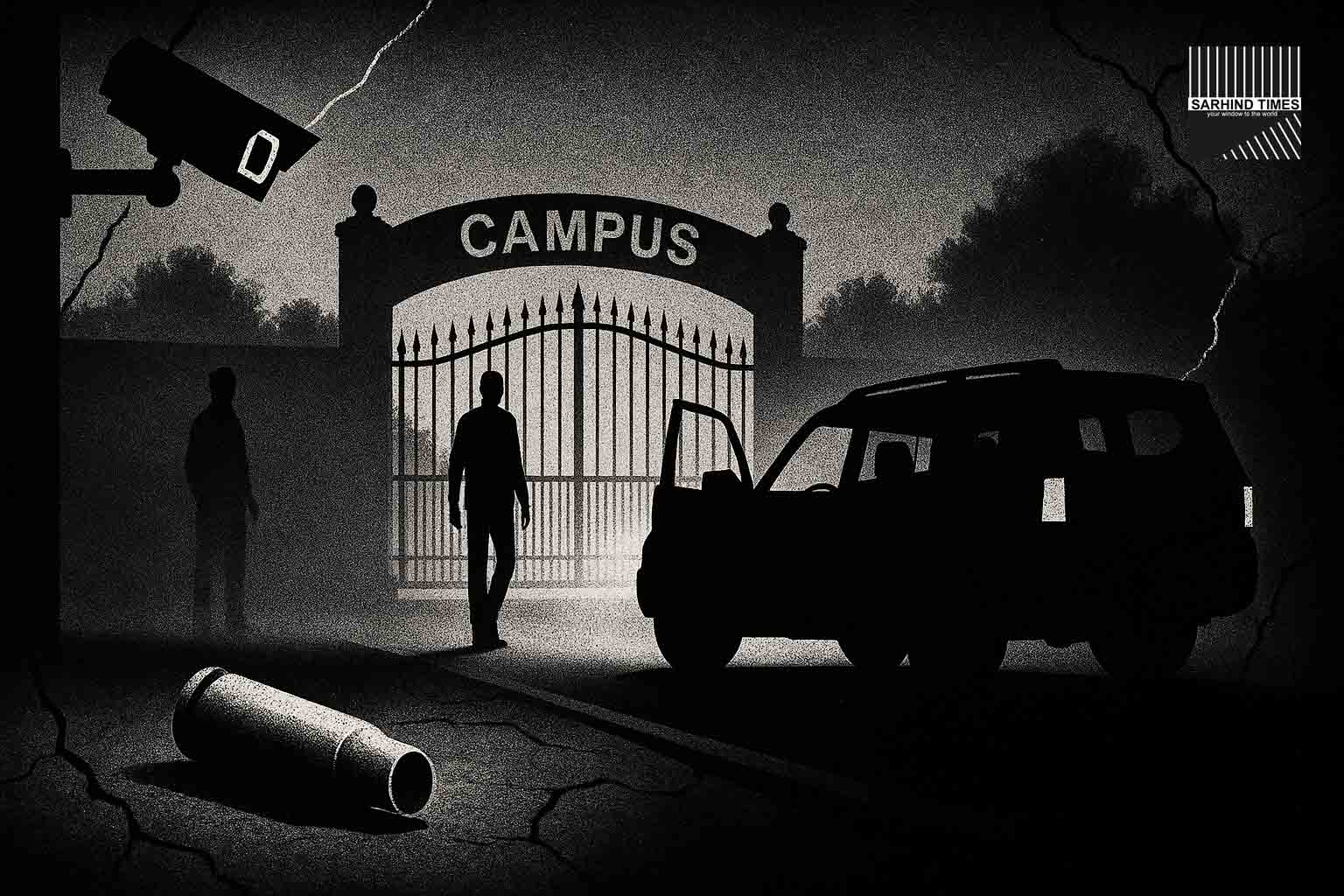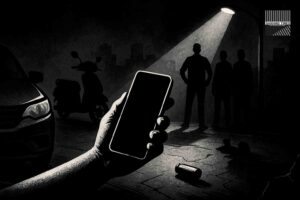Gurugram, Sept 26, 2025 — In a startling turn of events following a college festival, Gurugram police have registered an attempted murder case against six individuals, among them engineering students of a private university, after a 20-year-old student was allegedly shot outside the campus gate. The incident took place late Wednesday evening in Bilaspur (Kapdiwas area), near the campus auditorium. As police scan CCTV footage, call logs, and patrol the area, the case has brought renewed focus on campus security, crowd control at college events, and gun safety in urban fringes.
Early reports indicate that the victim, Sahil (third-year CSE student), was jostling amid the crowd during the fest’s entry, and a scuffle broke out between two groups. After the event, one group confronted Sahil outside the auditorium gate, instructing him to “settle matters.” A Thar vehicle reportedly arrived with occupants of the rival group, and a single shot was fired before the assailants fled. An empty cartridge was recovered at the scene, and the FIR was lodged at Bilaspur police station. The identities of two students and those in the SUV are being verified. Security has been beefed up in and around the campus zone.
The Incident: Sequence & Scene
The festival evening & the spark
College festivals often draw crowds, music, lights and excitement, but also tension points—over access, privilege, seating, miscommunication, rivalry or showback disputes. In this case, Sahil was among students trying to enter the auditorium gate. During this entry process, clashes erupted—pushing, verbal altercations, and competing groups converged.
Witnesses say that tempers flared when someone pushed past Sahil, triggering verbal retaliation. The festival security or gate staff may have intervened late. As the event concluded, the tensions had not diffused; instead, one faction apparently pursued the dispute outside.
Confrontation at the gate & escalation
Outside the gate near the Bilaspur area (Kapdiwas), the opposing group confronted Sahil and demanded a “settling” of grievances. At that moment, a Thar vehicle appeared, bringing additional associates. As Sahil and his group braced for confrontation, a shot rang out, allegedly from the direction of the vehicle or its occupants.
Sahil was struck (though details of wound location/severity are yet to be fully disclosed in the FIR). The attackers immediately fled, possibly via the same vehicle. Bystanders and students alerted local police; campus guards may have scrambled to preserve the scene.
Evidence & early police work
- An empty cartridge was recovered near the spot, indicating a firearm was discharged.
- CCTV cameras in and around the campus entrance, streetlights, and nearby shops are being reviewed.
- Call and mobile phone records of students present during the festival and of persons near the location are being requisitioned.
- Police have stepped up patrols in the vicinity of the university campus, checking vehicles and querying student movements.
- The FIR names six accused — likely the persons in the vehicle and some students involved in the initial scuffle — under attempted murder and other relevant penal provisions.
As the investigation proceeds, verifying ballistic trajectory, shell case matching, and witness statements will be paramount.
Legal & Investigative Dimensions
The FIR & charges
The First Information Report (FIR) includes:
- Attempt to murder (Section 307 IPC)
- Using a firearm, discharging in public
- Criminal conspiracy / abetment, if multiple persons coordinated
- Possibly dangerous weapons (Arms Act violations)
- Additional charges for unlawful assembly, rioting or breach of peace, if applicable
Given that students are involved, juvenile or educational institution policies may also enter domain, but as Sahil is 20, he is an adult under law.
Evidence challenges & procedural priorities
- Ballistics & forensic matching
The empty cartridge must be tested, and matched to the weapon (if recovered). Gunshot residue (GSR) on clothing, hands of suspects or vehicle interiors may be pivotal. - CCTV & camera angle clarity
Cameras may not have ideal angles; visual clarity (night lighting) may hamper identification. But linkage across multiple cameras may help reconstruct paths. - Call logs & phone geolocation
Mobile tower pings and logs may reveal who was in proximity, who called whom, and align alibis. - Witness statements & consistency
Students, campus staff, guards, bystanders will be critical witnesses. Their statements must be recorded promptly, before memory fades or intimidation occurs. - Preservation of scene & chain of custody
The spot must be cordoned, evidence preserved. Any contamination (crowd walking over cartridge) must be noted in police reports. - Vehicle identification & tracing
The Thar’s registration, ownership, route, passengers must be traced. If altered plates or shell vehicles used, forensic tracking may be harder. - Institutional responsibilities
The private university may come under scrutiny for campus security, access control, fencing, lighting, CCTV coverage, crowd management protocols.
Speed, accountability & pressure
Because a student was shot, public attention will mount. The police will be under pressure to act swiftly — make arrests, produce suspects in court, deploy preventive measures. Delays or lax follow-through may fuel protests or clashes.
Also, given that students are involved, parent bodies, campus unions or legal aid groups may intervene, demand transparency or monitor fairness.
Broader Issues: Campus Safety, Violence & Urban Risk
College fests & risk topology
College festivals are high-energy events with music, crowds, drinking, competition, emotional investment. They carry risk of conflict escalation, especially when rival student groups, outsiders or external gangs mingle. Security protocols must be preplanned: multiple entry-exit gates, segregated “VIP” and general access, metal detectors, bag checks, police presence.
Gun violence in urban peripheries
In India, firearm misuse outside law enforcement is illegal and rare, but urban sprawl, porous peripheries, weapon smuggling or black-market arms allow occasional discharges. In this instance, the fact of a firearm being used in a campus perimeter context is alarming.
University’s duty of care
Universities must ensure:
- Controlled access, perimeter fencing
- Adequate security personnel, especially at gates
- CCTV coverage inside and outside
- Night lighting and emergency call systems
- Liaison with local police
- Rapid response protocols for medical emergencies
If a campus is not safe, students’ confidence declines and institutional reputation suffers.
Youth, anger & conflict escalation
Young adults, competition, peer pressure, alcohol or excitement can cause small confrontations to escalate rapidly. A shove or insult can spiral into deadly consequences if weapons enter the equation.
What Happens Next & What to Watch
Arrests & suspect production
Police must trace and arrest the six persons named in the FIR. They may also identify additional co-accused. Search warrants may be issued on residences, vehicles, phone records, social media.
Once arrested, they must be produced before court in time, remanded or held as per judicial order.
Forensic & ballistics report delivery
The ballistic analysis, GSR tests, firearm matching and forensic lab reports will determine how strongly the prosecution case stands. Delay in reports can stall trial momentum.
Campus security audit & interim orders
Police or District Magistrate may order enhanced security at the university—checkpoints, frisking, prohibiting outsiders for a period, increased patrols.
Judicial orders may be sought by victims or student bodies to demand safety measures or investigation oversight.
Institutional, academic & reputational fallout
The university may face:
- Media scrutiny, student angst
- Legal or regulatory challenges
- Pressure to reform security, safety protocols
- Potential liability claims if lapses are found
Dialogue on stricter laws, gun control, campus safety norms
The case may reignite debate over:
- Firearm licensing, stricter control
- Campus security guidelines by UGC or state governments
- Protocols for use of force, emergency response
- Mandatory CCTV coverage extending to peripheries
Sample Timeline (Hypothetical Reconstruction)
| Time | Event / Action |
| Evening, during fest | Sahil and others enter auditorium; jostling begins near entry |
| Late evening | Verbal argument escalates between two student groups |
| After program ends | One group confronts Sahil outside gate, demands “settling” |
| Moments later | A Thar vehicle arrives; additional persons disembark |
| A shot fired | Sahil struck, attackers flee |
| Nearby students / staff alert police | FIR lodged at Bilaspur PS |
| Recovery | Empty cartridge recovered at scene |
| Investigation begins | CCTV scanning, call records requisitioned, patrols deployed |
| Next hours / day | Identities of some suspects established; police begin raids / tracing |
Human Angle: Victim, Students & Community Sentiment
- Sahil, aged ~20, is a third-year CSE (Computer Science & Engineering) student. His friends, classmates and family will be in shock.
- Student body may become anxious, fearful, calling for better campus security.
- Some may demand justice, protest, press statements.
- Parents may exert pressure on college administration to tighten management.
- Local residents around Bilaspur / Kapdiwas may feel unsafe, pressurize local policing.
The community will expect transparency, no shielding of suspects, and a fair investigation.
#Gurugram #CampusSafety #Crime #Haryana






















+ There are no comments
Add yours